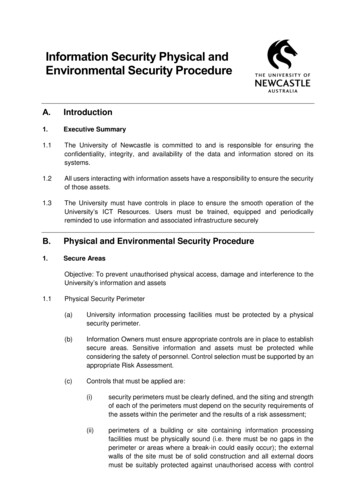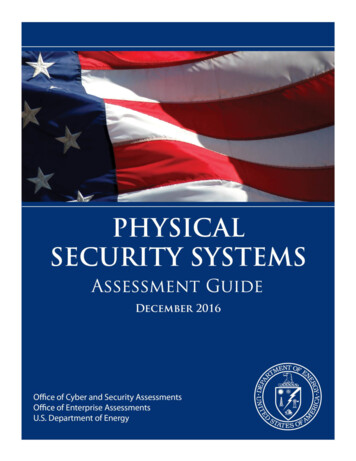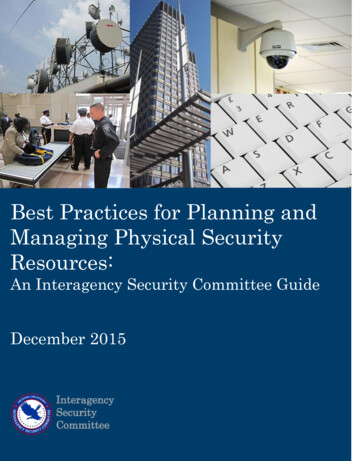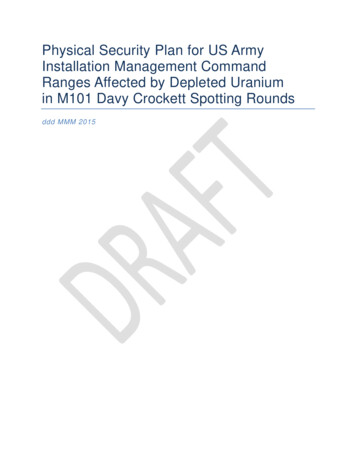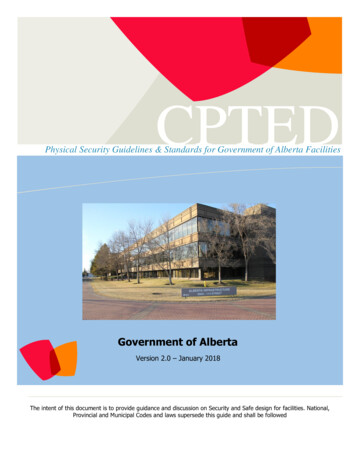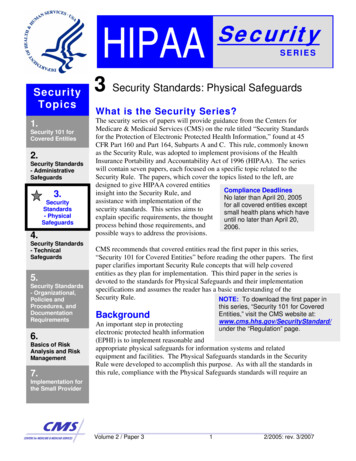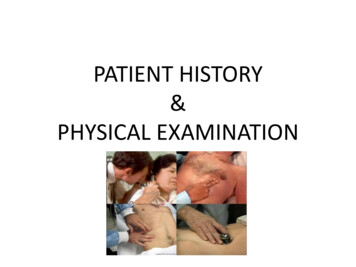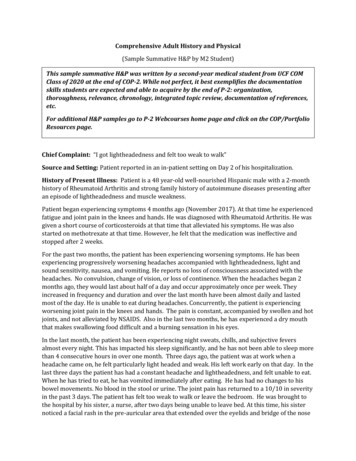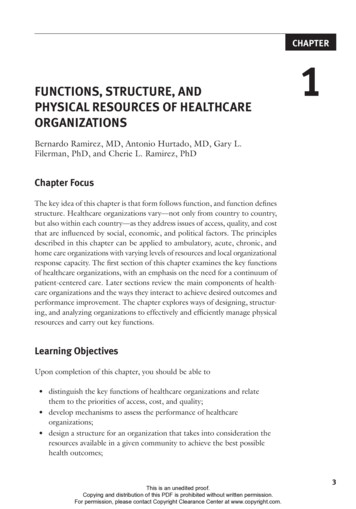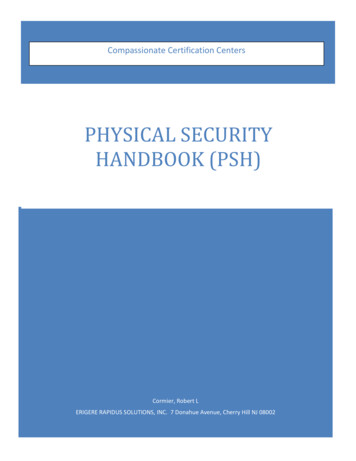
Transcription
Compassionate Certification CentersPHYSICAL SECURITYHANDBOOK (PSH)Cormier, Robert LERIGERE RAPIDUS SOLUTIONS, INC. 7 Donahue Avenue, Cherry Hill NJ 08002
1
Compassionate Certification CentersPhysical Security ProgramOffice of SecurityErigere Rapidus Solutions, Inc.Chapter 1: Physical Security Program-Purpose1.1 Purpose1.1.1 Compassionate Certification Centers (CCC) has a duty to provide reasonable operatingpolicies, procedures, and practices for the physical protection of personnel,infrastructures, and assets from deliberate and unforeseen threats at all their officelocations.1.1.2 These standards outlined in this policy shall be applied to all CCC facilities, owned,leased, or occupied space. Compliance shall be mandatory for all new construction,relocation, and renovation projects. Existing CCC facilities are not required to beupgraded unless a risk assessment determines otherwise.1.1.3 These standards shall be used by CCC Management or their designated securitycontractor to serve as guide for: the development of threat assessments; evaluatingsecurity conditions during real estate market surveys and using the requirements guide forarchitectural and engineering (A&E) design efforts. Nothing in this policy handbook shallbe construed as contrary to the provisions of any statute or other Federal, State or Localregulation. In the event of conflict, specific statutory provisions shall apply.1.1.4 Physical Security Programs shall be administered based on the policy set forth in thishandbook to ensure the protection of all CCC assets, patients and visitors. Theseprograms shall be continually and effectively administered and monitored to ensure theirintegrity. At a minimum, a Physical Security Program shall include the items listed inCHAPTER 2.12
Chapter 2: Physical Security Program-CCC Policy2.1 Policy2.1.1 It is CCC’s policy that personnel, facilities, property, information and other companyassets shall be provided a consistent minimum level of protection. The minimum physicalsecurity standards provided in this CCC Physical Security Handbook (PSH) ensure a safeand secure work environment that contributes to the successful accomplishment ofCCC’s mission to raise the level of treatment patients receive while seeking their medicalmarijuana cards by providing trust, clarity, diagnostic help to find the right medicine.This policy includes but is not limited to: Development of minimum physical security standards for CCC Offices and regionalfacilities, by identifying requirements for all physical security systems, devices, andbuilding features. These requirements shall be applied to new construction,renovation, and relocation projects, as well as projects involving securityenhancements; Conduct of periodic surveys, inspections, and other formal on site threat andvulnerability assessments; and Participation in security projects managed by CCC’s contract security firm. Thisincludes the evaluating of CCC compliance with federal, state and local governmentsregulations and standards for physical security requirements.2.1.2 All new construction, relocation and renovation projects must be coordinated through theCCC Security team to ensure compliance with applicable regulations and policies.2.1.3 Proposed Changes or Revisions: It is intended that this handbook become a livingdocument. As such, users of this policy handbook are encouraged to submitrecommended changes and comments to CCC Management on the Appendix formmarked: Policy and Procedures Handbook Comment. Comments shall reference thespecific chapter and paragraph, and shall include a justification for the proposed change.Periodic revisions to this handbook will be published as necessary and to the extentpracticable.3
2.1.4 Protection Criteria: CCC Management and their designated contract security firm shalldetermine the level of normal protective service on a case by-case basis. The facility’slocation, size, number of occupants and configuration; history of criminal or disruptiveincidents in the surrounding area-not primarily directed toward CCC’s mission, the extentof exterior lighting, presence of physical barriers or other factors may be deemedpertinent and will be taken into consideration in the assessment.2.1.5 Physical Protection: CCC shall provide normal and special protection through mobilepatrol or fixed posts manned by contractually engaged uniformed personnel; securitysystems and devices; locking building entrances and gates during other than normalhours; cooperation of local law enforcement agencies; and a combination of thesephysical safeguards, depending upon the location and the degree of risk defined. Thedegree of normal and special protection is determined by completion of a ERS physicalsecurity assessment or crime prevention assessment and implementation of CCC’sminimum standards contained in this policy handbook.2.1.6 CCC shall delegate some of the protection responsibilities to the senior CCC managerhaving responsibility of the space. However, CCC Senior management shall beresponsible for the procurement, installation, maintenance of physical security equipmentand systems, and procurement and management of any guard contracts.2.1.7 CCC Senior management is responsible for determining the degree of protection to beprovided the space. The level of protection shall be based on a physical security survey ofeach facility conducted by ERS or other contract security service using the guidelines andrequirements cited in this handbook to evaluate the security of that facility on a case-bycase basis considering the facility's location, size and configuration, number ofoccupants, and area’s receptiveness of the mission.4
2.1.8 Design Factors: It is imperative that security systems and procedures are consideredfrom the start of the design phase so that conduit runs and alarm wiring, structuralrequirements, reinforcing devices and other necessary construction requirements areprovided in the original plans.2.2Policy Exception Requirements2.2.1 General: In rare situations where compelling operational requirements or conditionsnecessitate deviation from the specific minimum requirements in this handbook, CCCmanagement shall: Document in writing any necessary exceptions from the requirements in thishandbook prior to approval of the design concept; Complete, if possible, a mitigation plan that states what measures will be taken tominimize security vulnerabilities. Document how the proposed mitigation planreduces risk to an acceptable level when compared to operational requirements;include persuasive evidence that the security of employees, assets and facilities willnot be compromised by a less than standard facility; Include justification, risk analysis, cost comparisons, criteria applied, and otherpertinent data. Lack of funds or cost savings do justify an exception, but all effortsshall be made to provide alternative security measures.2.2.2 Exceptions that are approved will be for fixed term, unless specifically noted allexceptions will be granted for one fiscal year. At the close of a term of the exceptionCCC shall reexamine the security needs of the facility.Chapter 3: Physical Security Program-Background3.1Background3.1.1 Perimeter Security: Perimeter security standards pertain to the areas outside CCC control.Depending on the facility location, the perimeter may include sidewalks, parking lots,outside walls of the building, a hallway, or an office door. The elements of perimetersecurity are: parking, closed video surveillance system, lighting, and physical barriers.5
3.1.2 Entry Security: Entry security standards refer to security issues related to the entry ofpersons and packages into a facility. The elements of entry security are: receiving/shipping, access control, and entrances/exits.3.1.3 Interior Security: Interior security standards refer to security issues associated withprevention of criminal or unwanted activity within the facility. This area concernssecondary levels of control after people or things have entered the facility. The long-termelements of interior security are employee/visitor identification, utilities, and occupantemergency plans.3.1.4 Security Planning: Security planning is the development of long-term plans thatincorporate requirements, standards, procedures, and processes to implement preventiveand responsive countermeasures in the event of a breach of CCC security.3.1.5 Security Planning: Sets security standards addressing broader issues with implicationsbeyond security at a particular facility. The elements of security planning are: intelligencesharing, security awareness training, tenant assignment, administrative procedures, andconstruction/renovation.3.1.6 Security Program: A comprehensive security system provides protection against adefined set of threats by informing the user of attempted intrusions and providingresistance to the would-be intruder’s attack paths. This resistance must be consistentaround the entire perimeter of the protected area.3.1.7 Elements of Security Program: There are four main security elements that must beproperly integrated to achieve a proper balance of physical security. These are:6
Detection: This is the process of detecting and locating intruders as far fromthe protected areas as feasible. Early detection gives the user more time foreffective alarm assessment and execution of pre-planned response; Assessment: Assessment is determining the cause of the alarm or recognizingthe activity. This must be done as soon as possible after detection to preventthe intruder’s position from being lost; Delay: Intruders must be delayed long enough to prevent them from achievingtheir objectives before the response force can interdict them; and Response: A response force must be available, equipped, and trained toprevent the intruders from achieving their objective. The response time mustbe less than the delay time if the response force is to intercept the intrudersbefore they achieve their objective.Chapter 4: Physical Security Program-Supervision4.1 Program Head-Chief Executive Officer4.1.1 The Program Head: defined as the highest-ranking individual, is the Chief ExecutiveOfficer (CEO). The Program Head, in addition to other duties, is responsible for ensuringthat security management duties, as defined in this CCC Physical Security Programmanual, are carried out effectively and efficiently. The Program Head shall delegateduties as needed and detailed in the PSH.4.2 Associate Program Head-Chief Operating Officer4.2.1 The Associate Program Head: defined as the highest-ranking individual within thecomponent of operations, is the Chief Operating Officer. The Associate Program Head isdelegated the duties of the Program Head for operational purposes.7
4.3 Office Management4.3.1 Office Management: oversees a wide range of functions including day to day CCC operationsand the direct supervision of the security program for CCC. Under the general supervision of theAssociated Program Head, has been appointed to discharge these responsibilities.4.4Contract Security Personnel4.4.1 Director of Security: Responsible for the design, implementation, testing andmonitoring of the entire physical security program, internal investigations,background investigations and other duties as assigned;4.4.2 Supervisory Security Officer: Responsible for overseeing the day to dayoperations of the Security Center (SC) which is responsible for life safety andemergency response in CCC offices and for Occupant Emergency Planning.Occupant Emergency Plans (OEPs) shall be required for all CCC facilities andinclude evacuation and Shelter-In-Place (SIP) protocols and procedures andencompass all hazards that may be encountered in the workplace (e.g., fire, severeweather, bomb threats, terrorism, and earthquakes). The Director of Securityoversees the CCC emergency response plan, including emergency medicalresponse, and delegates daily operations to the SSO.Chapter 5: Physical Security Program-Facilities Protection5.1 General5.1.1 The degree of facility protection shall be determined by the Program Head, AssociateProgram Head and the Security Director based on the results of a comprehensive securityassessment of the facility.5.1.2 Perimeter protection is the first line of defense in providing physical security forpersonnel, property, and information at a facility.5.1.3 The second line of defense, and perhaps the most important, is interior controls.8
5.1.4 The cost of security controls above these minimum standards normally shall not exceedthe monetary value of the item or areas to be protected, unless necessitated through anassessment5.2 Planning Facility Protection5.2.1 The objective of planning facility protection is to ensure the integrity of operations andthe security of assets. Security planning must be an integral part of selecting, designing,constructing, reconfiguring, or moving into a CCC facility.5.2.2 The modification of a facility or addition of security measures after occupying a facilitycan be costly and impractical. Therefore, the responsible Project Manager will coordinatefrom the outset, on any addition, alteration, or new construction with the Program Head.The coordination shall begin with the funding and concept phase, including the designersand architects and continue through the contracting process, actual construction,installation, and acceptance.5.2.3 When CCC occupies leased facilities, it is imperative that the Program Head and SecurityDirector establish a working relationship with the lessor and local law enforcementofficials. If the leased property has a Building Association, both should be active at allmeetings.5.2.4 Facility Protection in CCC-owned or leased Facilities: The degree of protection to beprovided for the space will be determined by the physical security assessment conductedby the Director of Security. The assessment will evaluate the security of that specificfacility, taking into consideration th
oversees the CCC emergency response plan, including emergency medical response, and delegates daily operations to the SSO. Chapter 5: Physical Security Program-Facilities Protection 5.1 General 5.1.1 The degree of facility protection shall be determined by the Program Head, Associate Program Head and the Security Director based on the results of a comprehensive security assessment of the .
